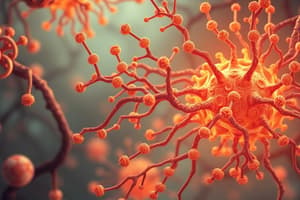Podcast
Questions and Answers
What was Patient E originally prescribed opioids for?
What was Patient E originally prescribed opioids for?
Back pain.
What substance did Patient E start using after prescription opioids?
What substance did Patient E start using after prescription opioids?
Heroin.
What emergency treatment did Patient E receive after two overdoses?
What emergency treatment did Patient E receive after two overdoses?
Naloxone nasal spray.
What two forms of therapy are discussed with Patient E for his opioid use disorder?
What two forms of therapy are discussed with Patient E for his opioid use disorder?
What was Patient E's response to methadone maintenance?
What was Patient E's response to methadone maintenance?
After what timeframe did Patient E experience a relapse following detoxification?
After what timeframe did Patient E experience a relapse following detoxification?
What long-term treatment approach did Patient E decide on after his relapse?
What long-term treatment approach did Patient E decide on after his relapse?
What key factor did the clinician emphasize about opioid use disorder?
What key factor did the clinician emphasize about opioid use disorder?
Flashcards
Opioid Use Disorder
Opioid Use Disorder
A chronic disease characterized by compulsive opioid use despite negative consequences.
Synthetic Fentanyl
Synthetic Fentanyl
A highly potent synthetic opioid often used in place of heroin and leading to accidental overdose.
Naloxone
Naloxone
A medication that reverses opioid overdose.
Methadone Maintenance
Methadone Maintenance
Signup and view all the flashcards
Buprenorphine/Naloxone
Buprenorphine/Naloxone
Signup and view all the flashcards
Relapse
Relapse
Signup and view all the flashcards
Medication-Assisted Treatment (MAT)
Medication-Assisted Treatment (MAT)
Signup and view all the flashcards
Chronic Pain
Chronic Pain
Signup and view all the flashcards
12-step meetings
12-step meetings
Signup and view all the flashcards
Drug Counselor
Drug Counselor
Signup and view all the flashcards
Detoxification
Detoxification
Signup and view all the flashcards
Biologic Basis of Substance Use Disorder
Biologic Basis of Substance Use Disorder
Signup and view all the flashcards
Study Notes
Case Study of Patient E
- Patient E, 54, has active opioid use disorder
- Began using prescription opioids for back pain after serving in the infantry
- Eventually left military service and is now a construction worker
- Used heroin for 3 years, likely synthetic fentanyl
- Experienced two accidental overdoses requiring naloxone
- Diagnosed with opioid use disorder, residual chronic back pain, and opioid cravings
- Refused methadone maintenance due to daily dosing requirement and safety concerns related to machinery operation
- Partner received education on naloxone use
- Successfully completed 12-step meetings and detoxification within 5 days
- Experienced relapse after 6 weeks, revived with naloxone
- Enrolled in buprenorphine/naloxone therapy, aiming for monthly injections
- Advised of the importance of continuous counseling and understanding of potential relapses
- Importance of the biologic basis and lack of judgement surrounding substance use disorder was stressed
- Patient continues with 12 step meetings, individual therapy, and physical therapy for back pain
- Continued need of naloxone nasal spray for emergency use stressed during follow-up appointments
Studying That Suits You
Use AI to generate personalized quizzes and flashcards to suit your learning preferences.


